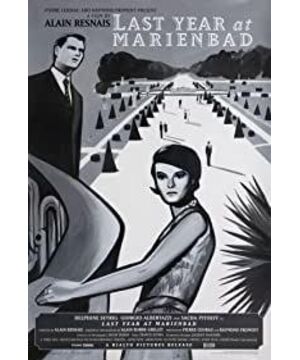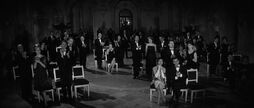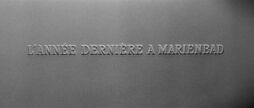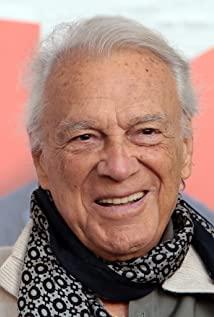is a good material to understand the background. Of course, the director's several interpretations of "Last year in Marienbad" are also quite interesting. But for reference only. Personally, I don't fully agree with the director's point of view. Rather than digging into the social significance themes of "Last year in Marionbad" and so on. I would rather take the movie as an unparalleled enjoyment in art.
In the castle, there is a static figure like a stone statue, and
a charming female face.
The two stills of "Last year in Marienbad" are forever buried in people's hearts. Behind these two extremes is the maze of pictures and language carefully designed by Ale Ho Griet and director Alan Renai, "Last year in Marienbad". When it was released in 1961, the reaction was unprecedented. It can be said to be a cultural waste of mystery, or it can be a revolutionary creation of aesthetics. This is a rare myth in the history of film. While the film aroused people's discussion, Renai and Ho Grille continued their confusing style. This maze is scary, but surprisingly attractive. Forty years have passed, let us enter the maze again, even if we get lost.
1. The rules of the game
"Try it out, the game requires two people"
The first is dialogue language. The emergence of new novels in the 1950s gave rise to a new cultural movement. Natalie Sarot, Claude Simon, and Michel Bierto are all people who tried to break through the limitations of traditional novels by publishing books, impacting the statement, plot, and character psychology of the novel, focusing on the narrative structure, Style, wording and sentence formation, and literature itself. In the mid-1950s, Alejo Griet quickly became the leader of the new trend. He was born in 1922 and was originally an agronomist. Then he published his debut work "Rubber" in 1953. Then published "The Peeper", "Jealous" and "In the Maze". In Huo Griyer’s novels, sluggish characters walk in seemingly endless labyrinths. New literature has also created a maze of words, which makes readers feel confused. At the end of the 1950s, the film began to change. In Europe, modern theater is shaking the dominant traditional theater. Filmmakers like Jean Luc Godard, Ingmar Bergman, and Michelangelo Antonioni have created a variety of narrative styles. The traditional concept of film editing, the control of film time, the film's soundtrack and even the role of the role have also been challenged. Alan Renai is a representative of modern drama. Born in 1922, he became popular by making short films. For example, "Under the War", "All Memories of the World", "Styrene's Hymn", and the famous documentary about Nazi concentration camps "Night and Fog". In 1959, he shot the first formal film "Love in Hiroshima". The original work is Margaret Duras. Resnai subverted all narrative films and took a different approach. Use non-stop repetition and short contrast techniques. Inspired by the success of "Love in Hiroshima", Resnai started his second film. Preconceived new novels and new drama trends are ready to sprout in this movie.
2. Begin to deal with cards
"It requires two people to play, and the cards are dealt like this."
In the early 1960s, Resnay was working on several films. He co-wrote a screenplay "Muriet, Suddenly Looking Back" with Jean Kellore, and "Harry Dixon" based on a comic book. These tasks have been put on hold. Because the producers Pierre Crowe and Raymond Furman suggested that Renai meet Aree Jo Griet.
Alejo Griet: Resnais didn't like my work very much at the time, and his understanding was not deep enough, but after meeting we hit it off. He read my work and is eager to try it. He wants me to create new things specifically for him. Resnais is very suitable for my work, a little bit rigid, a little formalism and illusion. That is to say, Resnais, like me, is definitely not building a stage for performances. Instead, the narrative is based on traditional realism.
The style of Resnais's short stories seems to be in line with the writer. "Below the War" is based on African anthropomorphic statues. "All Memories of the World" is a documentary about national liberation and it is thought-provoking. The roundabout corridor symbolizes the heavy-minded human brain. "Night and Fog" coldly depicts dehumanized institutions. From this point out, Huo Grille was created specifically for Renai. A week after the meeting, based on their discussions, the writer proposed 4 movie ideas. One is "The Undead", which was later filmed by Ho Griyer himself. The second was filmed in the movie Peng, and the third was filmed in the countryside. The last one was called "Last Year", which later evolved into "Last Year in Marienbad". Just like Resnay's short film, "Last Year in Marion Bard" is between personification and dehumanization. The characters are like souls out of their bodies or walking dead, like machines, suddenly activated. Under this deadly sky, a person named "X" in the script tried to persuade a woman named "A". They might have fallen in love in a certain town a year ago. That town is Karlstadt, or Frederiksbah, or Marionbad. But the woman forgot the encounter and denied it paranoidly. Like Resnay's earlier films, "Last year in Marionbad" describes a memory that is increasingly faint. In "Night and Fog", René and Kellow describe the story of the concentration camp. Let the world remember the tragedy in heart. "Love in Hiroshima" carefully uses the tragedy of Hiroshima as the background of an adultery incident. In "Last year in Marienbad", it successfully cannibalized the real world. The characters can be separated from reality, but the story itself is real, but it was forgotten a long time ago. In mid-July 1960, Alejo Grillet completed the script and delivered it to Arun Renai.
Are Hou Grille: In "Last year in Marionbad", I not only wrote the script, but also created the storyboard. Covering every scene and every shot of the movie, all editing has been conceived. I completed part of the director's work, but I did not participate in the filming work. The film was done independently by Alan Renai. He was very loyal to my original work when he directed it. We were in the same mind at the time, and he didn't want to modify anything. But he can still shoot his own style, which means he can capture people's psychology better than I write. Through subtle modifications, such as actors’ performances and sound effects, there are many places that are not easily detectable. Readers of the book may think they are the same after watching this film. I published the version delivered to Resnais, so it is exactly the same
, but it is also different.
Just like Emmanuel Riva (starring) in "Love in Hiroshima". Resnais is looking for stage actors to play the heroine created by Ho Griyer. In 1959, Resnai first met Daphne Sécuré in New York. At the time she was participating in Ibsen's "The Enemy of the People", and Resnay wanted her to play "Harry Dixon". But the film was not made, so he decided to let her play the role of "A" in "Last year in Marionbad". This is her debut on the big screen. Just like the filming of "Hiroshima Love", Resnai recorded the author's voice.
Ale Huo Grille: Let me read all the dialogues. All the dialogues of the male characters seem familiar to me. Daphne's calendar is not the case. The actor Amidaki told me later that he felt depressed when filming. Because Resnai asked the actors to listen to my recording, they were just drawing a gourd. Resnai personally guided Daphne Si Li, and did not let her listen to my recording. Only the role of Dafensi Li is like this. Resnai was rigorously faithful to my original work when shooting.
Casting is also the Italian actor Chioki Amidaki (playing the actor "X")
and Shasa Piduff (playing "M"), who is also an actor.
Huo Grille suggested that the scene be set in the casino in Vichy and the subway in Paris. Resnai chose the castles of Sereslin and Neuvenberg. Filming started in Germany in September and ended in October. Finally, the processing was completed in the Paris studio. The shooting lasted 59 days. After the editing is completed, the publisher has seen it. They felt inappropriate and refused to issue. "Last year in Marienbad" had to be secretive. Resnai and Ho Grille held a private screening for celebrities to watch. The film was originally dedicated to André Breton (French surrealist poet), it was the first people to watch it, but it was not well received. The film was also screened in front of Jean Paul Saud (French philosopher and writer), as well as Alberto Giacomettikto (French artist) and Antonioni. Finally, after winning the Golden Lion Award at the Venice Film Festival, the distributor decided to release the film in early 1961. "Last year in Marienbad" immediately set the trend, it became a must-see movie, arousing people's discussion.
3. At the beginning of the game,
"There are always rules" and "Odd numbers
are required to draw cards". It 's time to study the game of Marionbad. In this mysterious labyrinth, let us trace the personal, specious, and partial side of the movie. The first is the shooting location, a hotel described as a maze. Some are just doors, corridors, and mirrors, setting off an intricate atmosphere, intertwined with modern and classical music. The continuous picture has a sense of space that is broken in the structure. The narration repeats itself. Intermittent words make people lost in this world. Here time and space are repeated over and over again. The maze is full of numb, rigid characters. They don't eat, drink, or sleep. No feelings, no thoughts. It's like a walking dead, like a stone statue leaving the base, or a villain in a music box. When the music stopped, they stopped moving. Following some mysterious signal, the statue seemed to have been enchanted and woke up at night. All characters are thoughtless. Their words and deeds are like a continuation of the stage play at the beginning of the film. Mirrors and paintings are hung on the walls in the scene. The characters mechanically interpret the established plot they just heard. Sometimes they even copy and imitate each other. Like weak prisoners, although they do whatever they want, their actions are limited. They are just imitating. Living people don't exist, maybe they are dead, maybe they are sleeping in the room. They pretend to be playing a weird game, making meaningless conversations like robots. All characters are trapped in this false, artificial space, limited time and space, and it goes round and round.
"Last year in Marienbad" reminds us of another movie almost 20 years later. It is also a movie about ghosts, hotels, maze-like corridors, and tracking photography, that is Stanley Kubrick's "The Shining". In "The Shining", a writer spends the winter with his wife and children in a hotel without guests. The film also advertises the cycle of time. The writer in the film is cursed and has to experience a tragedy repeatedly. The tragedies occurred in 1921 and 1971. The similarities between the two pieces are not only that. In Kubrick's film, young Danny has a rich imagination and is immersed in a fantasy space. The writer was persecuted by delusion, he created another real world. Then his wife also fell into a terrifying virtual world. The film expresses the terrible imagination, which can be passed from person to person. "The Shining" is tantamount to a replica of Resnais' film.
Because "Last Year in Marienbad" is generally about imaginary space. In the mechanical space of "Last year in Marienbad", all the robots are different. One of them stood out from the crowd and tried to escape the maze. He is freer than everyone else. He has consciousness and even memory. In this dehumanized world, he is the only person with the ability to think. The narration seemed to follow his gaze, while the others simply repeated their actions. This man has an extraordinary imagination. This allows him to play freely. So as to escape from this mechanical world. She brought something that other robots lacked in the hotel for a long time: love. At first, the woman stood still. She might have turned out to be a statue. The man wants to try the impossible, he wants to bring this statue to life. Construct a past to confuse her. He used his imagination to make this woman break the rules. In the symbolic waltz scene, they dance endlessly with other robots. The man disrupted the woman's mechanical movements. Let this woman glimpse another possibility of parallel time and space. Other robots are just executing pre-programmed programs. They will close soon, but the two will continue. Soon, tears flowed like a spring, flowing on the cold face. Later, she could no longer sustain the monotonous voice, and said something that had long been forgotten. "If you love me, please leave!"
Standing on the cliff, the future is at a loss. The statue has emotions. Men must hurry up, time waits for no one. At a certain moment, just like a music box, these statues will stand still, waiting for the next drive, and start all over again. Many pictures of this woman are carefully placed in the drawer. It shows that the man has tried before, but every time he can't take her away before the deadline. Soon, everything will stop, as still as a statue in the garden. This time, he successfully transformed the woman. For the first time, she was able to compose the image of this man's imagination. Without her voice, the image of imagination can be passed on from person to person. The woman's heart is touched. The man successfully changed her thinking. Then after the film, the balance broke. For the first time, a woman's point of view appeared. From now on, without outside help, this woman can construct an imaginary picture. Now that he has taken the first step, this man can follow her far away.
robot? music Box? Imagine the picture? Can't it?
"The Shining"? "Last year in Marienbad"? Maybe.
There is another explanation for this work by Renai and Huo Grille. Huo Griyer listed Pierre Andro as the author of the quotation. Based on this, we make another hypothesis, what if this person realizes that he makes the character in the movie? In other words, "Last year in Marienbad" is the space to imprison him. The protagonist is locked in a limited fictional movie with repeated scenes. Always encounter the same rigid characters. He is like the masterless lonely soul in this silent film. The protagonist has to control the film, make it derail, and force an impossible love story from it. So he wanted to reform the woman and direct her like a director. Makes the scene very moving, and the film has to accept the emotions inside. For the same reason, the protagonist abandoned some scenes and spontaneously modified the scenes. His words affected the film, making it appear scenes that shouldn't have appeared. He rearranged the order of the pictures, although this caused a jump and broke the continuity. So "Last year in Marienbad" can also be a story about filmmaking. Among them, the character becomes the director, freely using the pictures and film language, and presents before our eyes like magic. The protagonist perseveres, and finally his dreams come true. He escaped from the fictional story and left the audience in front of the screen with the woman. The camera watched them leave, facing their weird departure, the film had to end with another ghostly character.
The character trapped in the film? good. Manipulating the video editing? Can't it?
We continue. Huo Griyer called Daphne's role as a symbol of Renai, then. The man can be regarded as a symbol of Huo Griyer, the author of this game. The film tells how Daphne Seri and Renai escaped from the narrator and the author, and finally gained freedom. "Last year in Marienbad" reflects the power struggle between the screenwriter and the director. The conflict between their ideas and imaginations. Both parties want to control the film.
There is another assumption. Because the length of the film is the same as the opening stage play. This film can also make the audience think about it because of the dullness. I sank myself into the play in this hour and a half. Since that's it. Who is the ghost haunting this maze? Why did the woman tear up a letter in the end? The discussion can continue. Various understandings constitute the contradiction of the film, and the film encapsulates this point. Resnais and Huo Grille have created a film full of imagination.
4. The game is over.
In "Last year in Marionbad", René and Grillet finally let go of their minds, that is, the political elements, the past and psychology of the characters, the theme of the film, the ethics and so on. The role has become very streamlined. The character cannot change the mood in the film. But through the conflict of language, setting, and editing, an uproar has been set off. In this abstract, icy labyrinth, magic works. Emotions are inspired by the core film creation. Huo Griyer quoted a passage to show his will.
"The painter looks at the criss-cross lines and draws out skyscrapers." This is reminiscent of a movie two years ago, which is Hitchcock's "The Bourneman". At the opening ceremony, simple horizontal and vertical lines brought out the skyscrapers of New York. It is also the geometry that covers the picture, and the form precedes the content. "Mystery" may be the main reference movie of "Last year in Marionbad", the shadow movie. In the picture, there are many arrows on the ground, road signs, crossroads, straight lines, and perspective drawings, which are real geometric mazes. In the film Gary Grant is an erratic spy. This is also a thoughtless character. The characters have been simplified to the utmost, with only the letters on the matchbox showing pure abstraction. In this formal world, it is true that oneself has love. When "Last year in Marienbad" was released, Renai and Ho Grille never mentioned Hitchcock. But in the tenth minute of the film, a picture of a suspenseful master suddenly appeared next to the elevator. Hitchcock's "Fangzhang" appeared in the film, right on the wall.
Let the suspense master make a final summary below. In their conversation with François Truffer, they were talking about "The Horror", and Hitchcock inadvertently summed up the success of the film "Last year in Marienbad". He said, "In "The Cry", the characters and the story are secondary. What is important is the combination of the following elements. Photography, soundtrack, various film techniques. Also, the presentation of the story should resonate with the audience. Audience. What moved it was purely the movie itself."
PS is
very fond of the white back shoulder transparent long ruffled sleeve dress and the black crochet lace tight dress on the poster, one black and one white, like a cross between reality and memory.
PPS has a special liking for the two appearances of the match-dropping math game. I don’t know if it’s swollen, and the rules of the game are swollen. Will people lose if they start to drip?
View more about Last Year at Marienbad reviews










